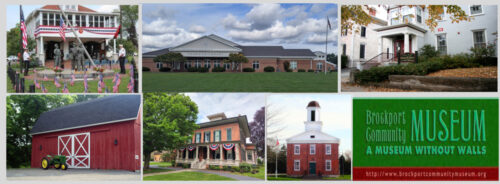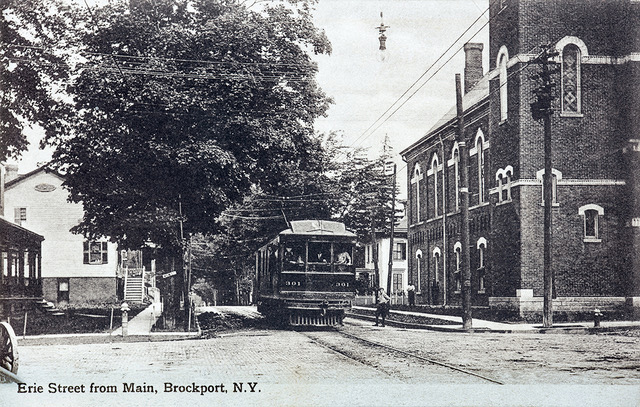Night at the Museums returns to highlight seven Brockport-area sites

Seven Brockport-area local history museums will open their “doors” to welcome visitors from 4 to 8 p.m. on Saturday, May 21, for the Night at the Museums event.
The unique event (whose name was inspired by the 2006 movie Night at the Museum) was first held in 2019, but due to the pandemic, it had to be postponed until this year. This free, family-friendly event will feature the seven local history gems open all at once, which is rare. All feature something different and will provide visitors with a sense of the history of Brockport and what a thriving canal village it was.
Participants can visit as many of the museums as they’d like during the open hours; however, new this year is the Night at the Museum Passport. A family will receive the passport at the first museum they visit. If they have it validated at each participating museum and turn it in at the last museum visited, they will be entered into a collective door prize drawing.
Visitors can start and end their evening at any of the seven museums.
Capen House Co. No. 4 and Fire Museum
237 Main Street South, Brockport
The Capen Hose Co. No. 4 was constructed in 1905 to provide fire protection to the Brockport community. It is now a museum that houses a collection of Brockport firefighting apparatus, equipment, and uniforms dating back to the late 1800s. The site is also home to the Firefighters Memorial Monument, modeled after an iconic Associated Press photograph taken at Ground Zero during the aftermath of September 11, 2001. The monument was dedicated in August 2002.
Clarkson Academy
8343 Ridge Road, Clarkson
The picturesque Greek revival academy was built around 1853 using local bricks and lime mortar. It was used as a school until 1956. The building was vacant and dilapidated when Clarkson Historical Society began restoration work in 2003. In 2013 the society began using the restored academy (complete with vintage desks and blackboards) for school field trips, evening programming, and an annual summer camp to learn cursive writing.
Emily L. Knapp Museum of Local History
49 State Street, Brockport
Located in the former home of the Seymour family, the museum opened in 1945. Volunteers have worked diligently over the past ten years to restore and update the museum’s displays, catalog documents and photos. The two-floor museum has 15 display areas. A display highlighted for the May 21 event is The Brockport Fair. The organizers later purchased 34 acres of land along the Erie Canal, where the Fair expanded to include one of the best racetracks in New York State. It was a fair visited by tens of thousands of people from surrounding areas and continued until the late 1930s. See fair photos and memorabilia in this new section of the museum.
Morgan-Manning House
151 Main Street Brockport
Built in the mid-1850s, this 20-room Victorian house was the main residence of local entrepreneur D.S. Morgan and his family for 100 years. In 1965, it became the headquarters of the Western Monroe Historical Society, which undertook its restoration and management ever since. It is fully restored to Victorian splendor and welcomes visitors for tours, historical programs, and special events, most notably on the 4th of July.
Seymour Library and Local History Room
161 East Avenue Brockport
The story began in 1936 when James Seymour donated his home to become the Village of Brockport’s public library. The library became a successful and beloved part of the community. After outgrowing its home, Seymour Library opened its doors at the current location 25 years ago. During these years, the library has become a center of information and activities for the entire community. In 2015, the library added the Local History Room, which features an extensive local history collection and houses mini museums. The local history room is open during library hours year-round.
Sweden Farmers Museum
4988 South Lake Road, Brockport
The Sweden Farmers Museum is the Brockport area’s newest museum. It was created in 2005 by the Town of Sweden to celebrate the area’s agricultural history and promote the importance of local farming. The museum includes a restored, circa 1820s farmhouse and a barn from the late 1880s. The Sweden Farmers Museum is also the site of the annual Harvest Festival.
Brockport Community Museum
www.brockportcommunitymuseum.org
Marker dedication at 36 Erie Street, Brockport
The Brockport Community Museum will also be participating during the Night at the Museums and in-person this year. This “museum without walls” was chartered in 2002 and brings local history into the community with exhibit cases and interpretive panels located throughout the community.
The newest historic marker will be dedicated during the Night at the Museums from 4 to 4:30 p.m. A brief ceremony will be conducted by Alan Berry, President of the Brockport Community Museum, and Mayor Margay Blackman. The marker memorializes the Buffalo, Lockport, and Rochester Railway and its Brockport Trolley Depot at 36 Erie Street in what was formerly the Colonial Inn, Angus O’Brien’s, and Flash’s Tavern.
The marker was funded through a grant written jointly by the Village of Brockport and the Brockport Community Museum. The funding source is the William G. Pomeroy Foundation, which is currently the nation’s leading funder of historic markers. Located in Syracuse, the Pomeroy Foundation has placed over 900 markers, including the pole and shipping.
The electric interurban trolley provided an economical and convenient mode of transportation between Rochester and Buffalo and all points in between. The trolley was a critical transportation service for students enrolled at the State Normal School in Brockport.
The Brockport, Lockport, and Buffalo electric interurban was simply called “the trolley” by area residents. It operated from 1908 until 1931 and served as the primary form of transportation before the proliferation of the automobile. The trolley offered a convenient means for rural residents to commute to factories and business interests in Rochester. It was also used by Rochester residents and people living in surrounding areas to travel to the Brockport Normal School for education. Even high school students used the trolley to travel to various schools as this preceded the current system of central school districts and the idea of busing.
The trolley was also used to ship freight on special cars. Area farm produce and milk were shipped to Brockport via the trolley.
The proliferation of automobiles in the 1930s spelled the demise of the trolley, and it finally succumbed to the success of the new technology in 1931.
All are welcome to bring their friends and family to explore Brockport’s history during a Night at the Museums on Saturday, May 21.
Provided information and photos



